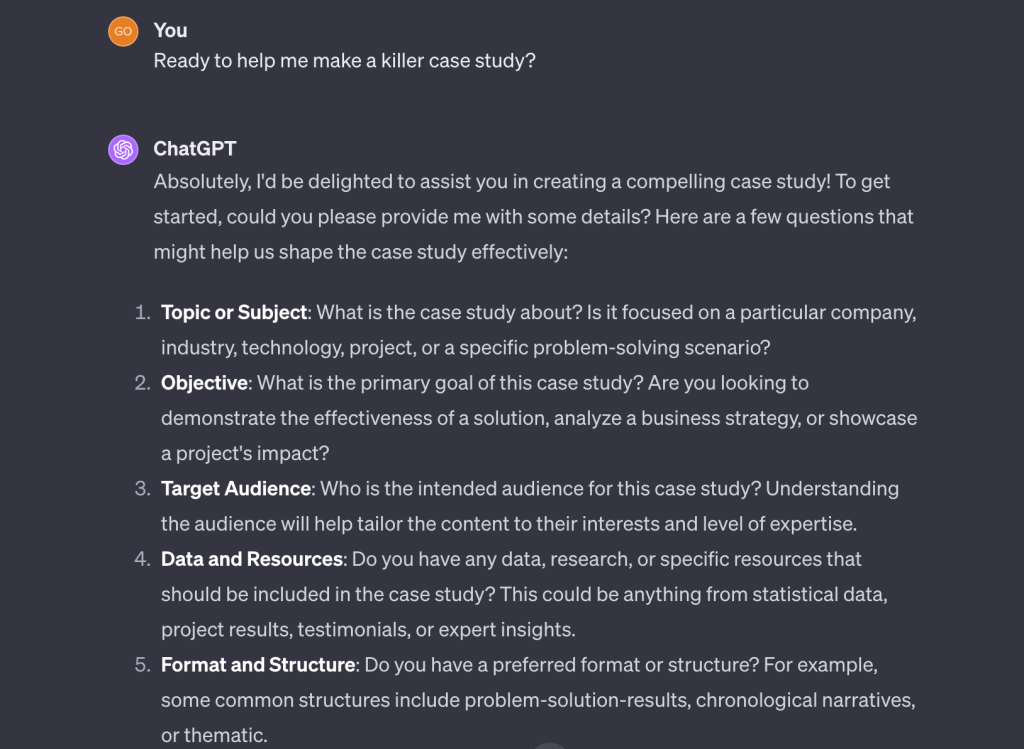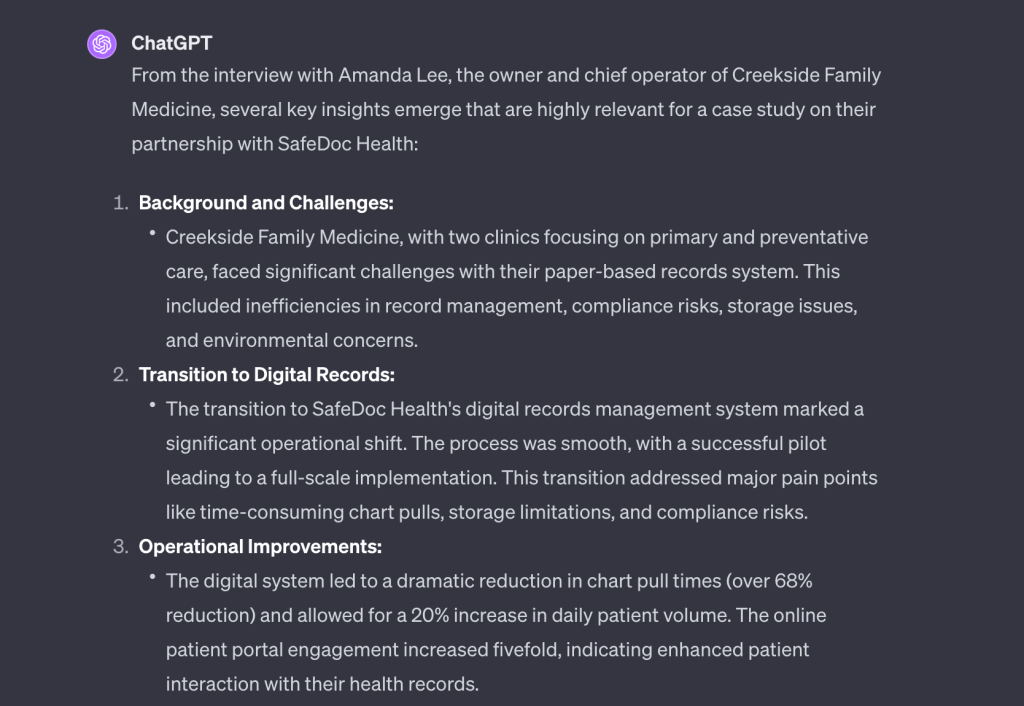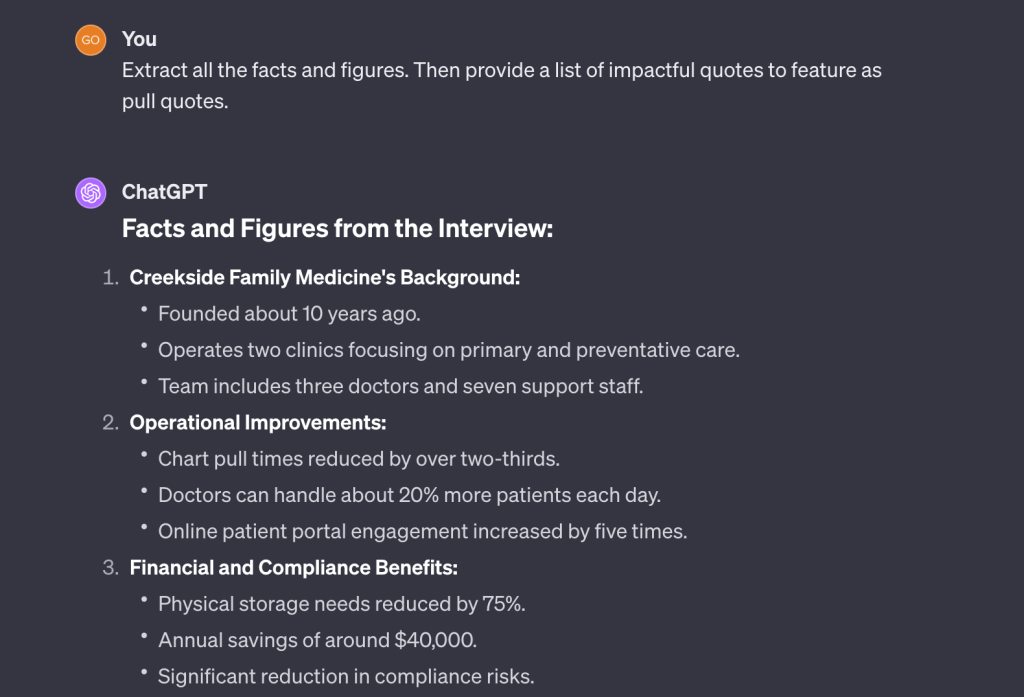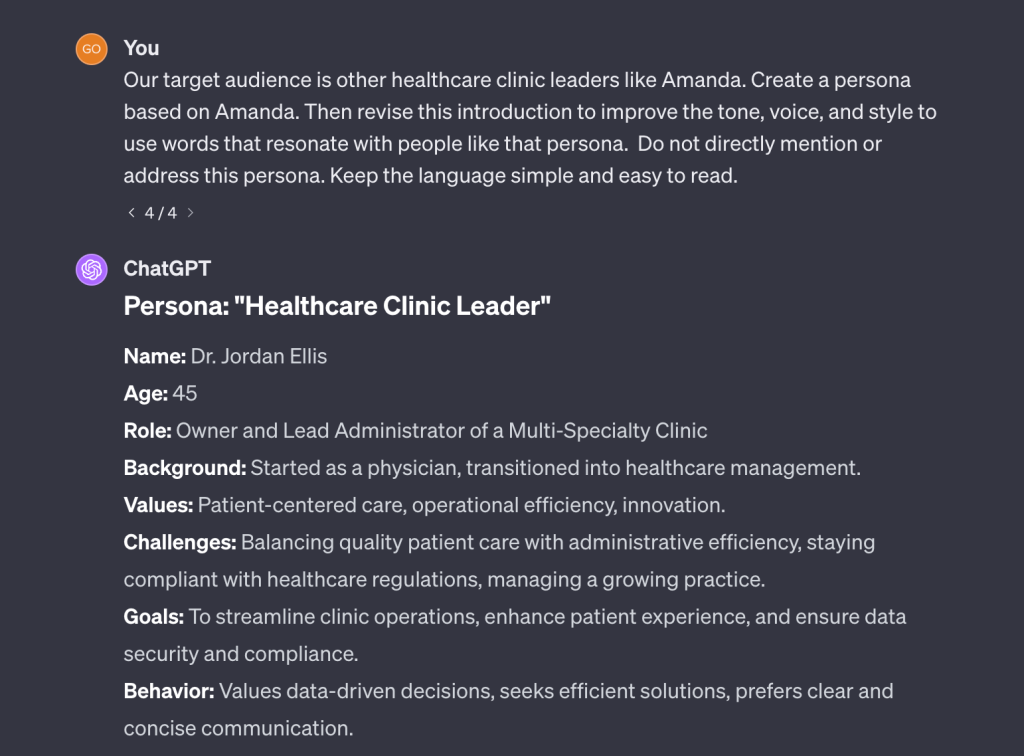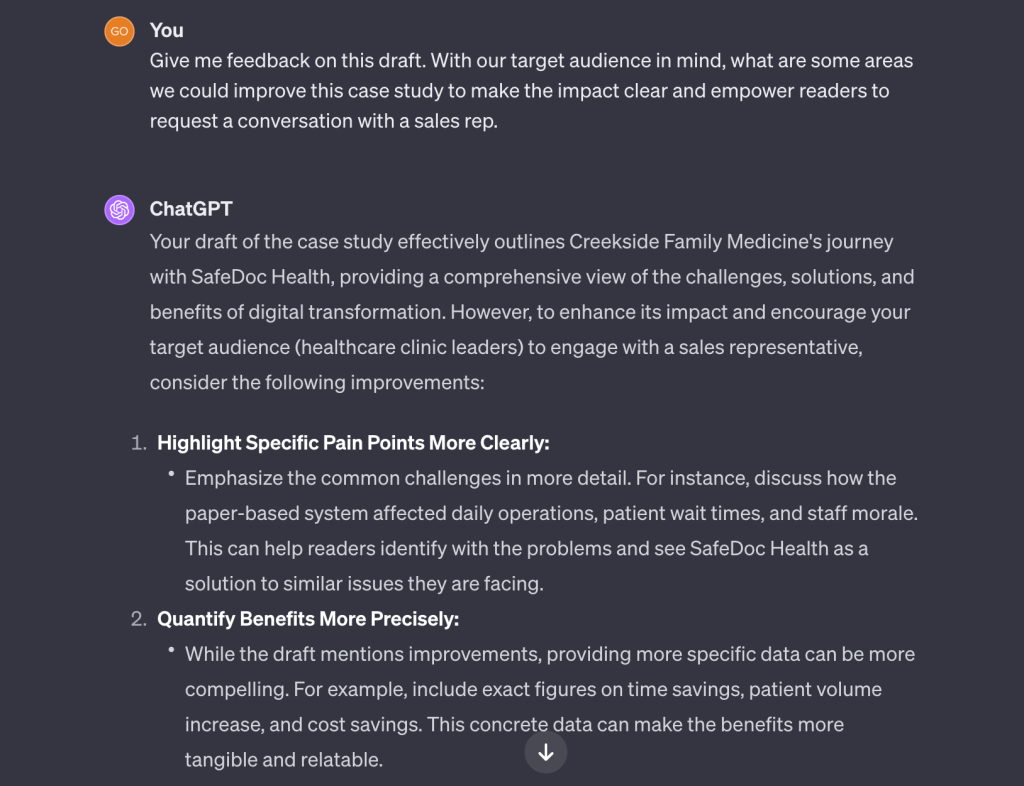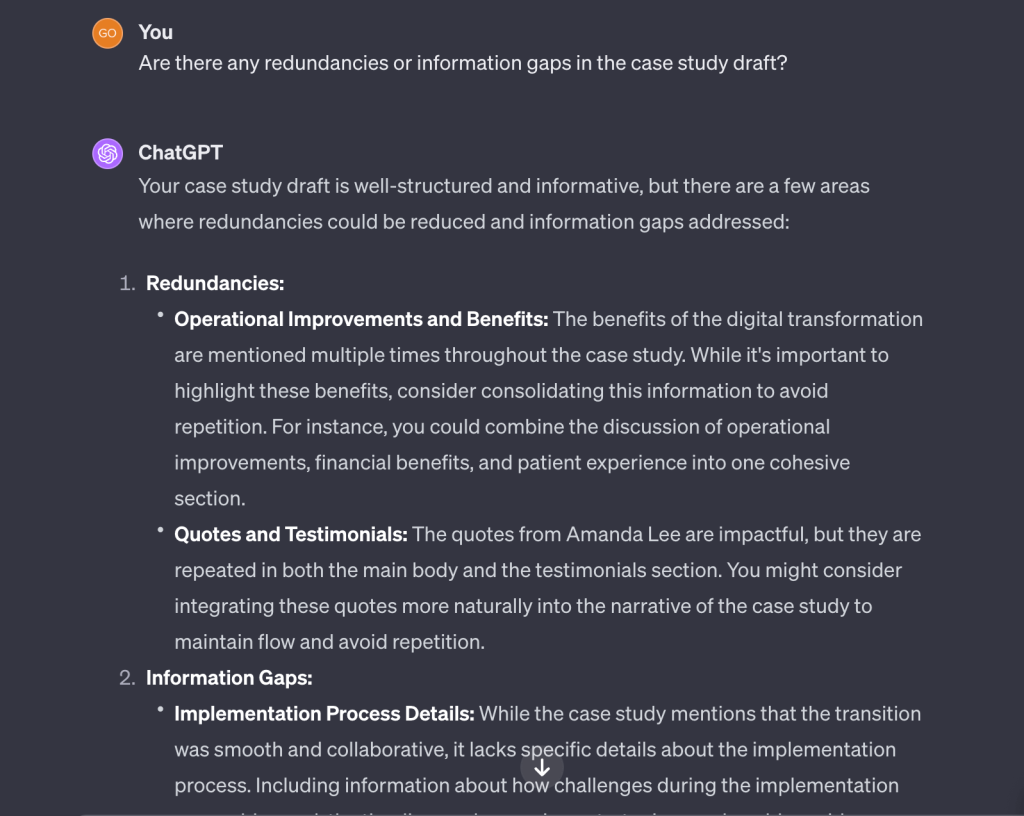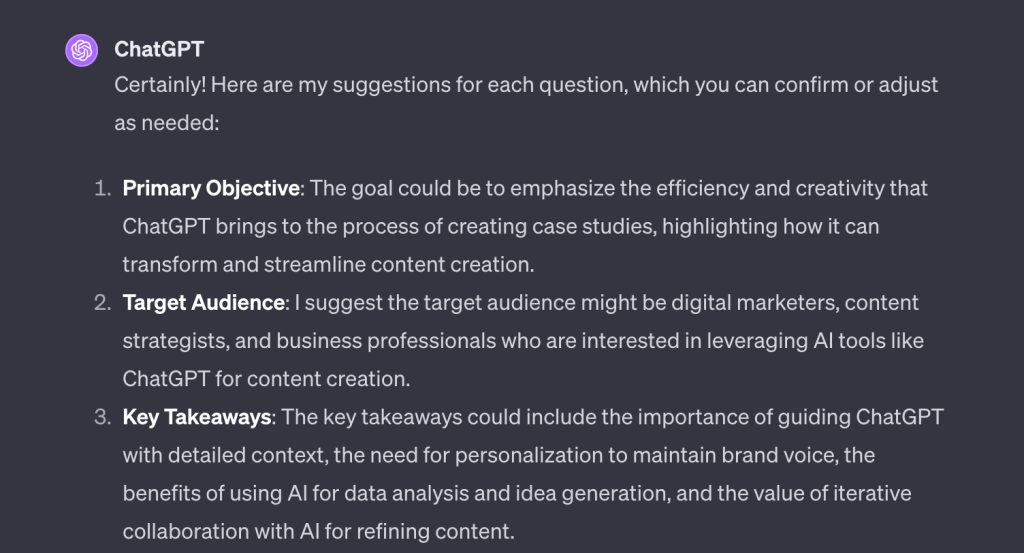How to Use ChatGPT to Create a Case Study
Case studies are pivotal in content marketing. They play a critical role in helping decision-makers choose and champion the potential value of your offering. But after a while, publishing case studies can become cumbersome and mundane. Shiny new AI-powered tools like ChatGPT might begin to feel irresistible. So, how can you use AI to create case studies?
Here’s how to use ChatGPT to assist you in creating case studies, in a nutshell:
- Analyze Your Data to Find Powerful Angles.
- Research and Plan Interview Question Ideas.
- Extract Details, and Quotes From Interviews.
- Build a Compelling Structure and Narrative.
- Draft and Revise Starting Points
- Tailor your Copy to Resonate With a Persona.
- Refine and Revise Content Based on Feedback.
Let’s get into the benefits of using large language models (LLMs) to assist you in developing case studies for content marketing. We’ll cover some limitations, helpful tips for achieving the best outcomes, and examples based on mock interviews. With this guide, you’ll be one step closer to improving your case studies with AI.
A real-life human with expertise in content marketing wrote this blog post – not AI.
The benefits of AI for Case Studies
A marketing case study is a type of long-form content that follows a predictable pattern. Its goal is to convert a lead by convincing them of the benefits of your solution through a success story. This predictability is part of what makes them a good fit for assistance from conversational AI language models like ChatGPT.
LLMs like OpenAI’s ChatGPT and Google’s Bard have been trained on the structures and language patterns of many kinds of content, including case studies. These AI chatbots can process, interpret, and organize copious amounts of relevant case study data, ideas, and information much faster than any human.
LLMs can also…
- Add a creative edge to brainstorming ideas
- Help you learn about topical nuances
- Suggest fresh angles and perspectives
- Help improve your drafts clarity and relevance
Tired of repeating yourself? ChatGPT-4 now lets you customize your own chat interface that follows your rules and context during conversations. These custom GPTs fine-tune how the tool takes your direction to generate consistent outputs that meet your standards faster and with less refinement.
Using ChatGPT to Generate Case Studies
So we know that AI tools like ChatGPT can generate human-like text from prompts. They take the context from your conversational prompts to generate natural-sounding responses. If you’re clear about your goals, LLMs can be quite effective at brainstorming ideas, analyzing text, data, and images, and improving any part of your case study.
ChatGPT can also act as a feedback buddy to help you spot gaps in your story, predict objections and reactions, and fix redundancies – so you can bring your case studies to a whole new level. And, it can do all of this at lightning speed. Not only can you now create more compelling case studies with assistance from AI, you might even be able to do it faster.
Limitations of ChatGPT for Case Studies
ChatGPT has been criticized widely across the content marketing side of LinkedIn for generating boring, generic copywriting filled with hyperbole, bias, and sometimes nonsense. It’s been around long enough that, by this point, most people are catching on when text has been generated by an LLM and published with little to no proofing or editing.
Here are a few precautions for using ChatGPT for writing case studies…
- GPTs’ limited subject matter expertise can lead to irrelevance and is inherently unoriginal
- LLMs have inherent biases in their training data and can risk spreading and misinformation
- You must be aware of the implications and legal risks around confidential information you share
- Output quality relies on input quality
- AI generated text can completely miss the heart and soul of your voice
- GPT can repeat itself and overuse certain common words and phrases
As tempting as this may be, establishing and protecting the human element in your writing is crucial. This is especially true when representing your brand in the consideration stage of a prospect’s customer journey.
7 Ways to Use ChatGPT for Case Study Content Creation
ChatGPT can be your superhero sidekick when creating case studies. But it’s important to remember that its role is to assist you – not take over and do it all. The key to using ChatGPT or Google’s Bard to help you produce more compelling case studies is to start and finish with your own data and original human input.
For an AI-assisted case study that stands out (for good reasons), it’s up to you to train your LLM with the original ideas, facts, and outcomes you want to see presented.
Here is how to use ChatGPT to assist you in each step of creating case studies for marketing:
Analyzing Data
Where ChatGPT gets exciting is in analyzing both qualitative and quantitative data. Using AI to find patterns in data at the start of your project can be helpful when you’re searching for a case-study-worthy success story in the first place.
ChatGPT can now interpret and generate larger portions of text and read more file types like images, spreadsheets, and PDFs. It can quickly identify patterns and anomalies to help you find standout wins faster than even the speediest spreadsheet wizards.
Generating Interview Questions
Jazzy, creative copywriting does not make a case study great. What makes a case study great is asking the right questions about the star customer’s experience to draw out the most impactful answers that paint a persuasive story.
Your case study should position your customer advocate as the champion in this story – and the solution you’re promoting should be the ‘secret’ weapon they use to succeed.
During your research stage, you can use ChatGPT to help you make the most of your customer interview. Ask ChatGPT to generate specific, high-impact questions your interviewee will be surprised you thought to ask. If you’re not already familiar with the industry, AI can help you learn more about the nuances so you can ask better follow ups.
In this example, I provided ChatGPT with a (mock) statement from a sales representative and asked it to generate a list of questions I could bring to the interview. ChatGPT provided a series of specific questions grouped by theme, making it easy to browse by category and shortlist interesting interview questions. As always, more detailed prompts usually lead to more quality outputs.
Extracting Themes, Details, and Quotes From Interviews
Once you’ve interviewed the champion customer and solution provider SME, you can share these transcripts with ChatGPT as PDFs or text to extract key themes, ideas, details, and testimonials.
Extracting insights from interview transcripts is where the magic can happen. Instead of giving ChatGPT a raw list of stats and facts about the success story and letting it fill in the gaps, feed it an original narrative that can help the LLM assist you in turning it into a persuasive story.
Here, I shared a 2,700-word interview transcript with ChatGPT, prompting it to extract impactful insights relevant to a case study. This prompt was loose and generic, but the AI could still extract and categorize the key messages into a structured summary much more quickly than a person reading through the entire 25-minute conversation.
I took that one step further to pull the facts and figures mentioned in the interview, also asking for impactful quotes to feature. ChatGPT is pretty good at pulling and organizing the data points. If you’re specific enough about your goals and persona in your prompt, you can also try using it to spot specific individual statements from the interview that would resonate with your target audience.
How Much Text Can ChatGPT Process?
When working with large portions of text, ChatGPT and other LLM tools are limited in how many characters or words they can receive and send at a time. Longer words can reduce the word limit and take more time to process. Prompts and outputs are measured by ‘tokens’.
Here are the current token limits and numbers of words for ChatGPT according to OpenAI forums:
- ChatGPT-3.5 (the free version of ChatGPT): 1,000 to ~4,000 words (4,096 tokens)
- ChatGPT-4 (available with a paid subscription): 2,000 to ~6,000 words (8,192 tokens)
The paid version of ChatGPT allows you to work with larger ‘context windows’ than the free version. ChatGPT’s input and output character limits have improved over time and continued to, but there are tools like Claude that are competitively made to support even larger context windows.
Outlining a Case Study Story and Structure
Case studies usually follow a fairly conventional formula to simplify the process for potential customers when evaluating various brands and options. They typically must cover a few essential angles to result in successful lead generation.
Case studies usually look something like this:
- An introduction with key highlights and facts/figures
- An overview of the customer and their situation
- Challenges and pain points before the solution
- Choosing the solution, the experience, the benefits
- The astonishing outcomes, impact, and value
If you already have an established template for your case studies, you could start by giving ChatGPT an outline as simple as this – or with even more detail. Another option is to brainstorm and experiment with new formats, inspired by ChatGPT’s recommendations as well as your data, goals, personas, interview footage, and even competitor’s case studies.
ChatGPT-4 also has a new ability to visit links and analyze pages you share with it (assuming the site hasn’t blocked GPT’s bots.) This makes it easy to gather an analyze competitor examples at scale, so you can position your own case study wisely in the market.
Drafting Introductions, Summaries, and Rote Information
Even with lots of material available for ChatGPT to learn from, you shouldn’t let ChatGPT draft 100% of your case study. Your case study’s voice and style is too nuanced (and too human) for LLM to run solo through the finish line. Instead of generating the entire case study all at once, try working on it section by section. Get some early drafts flowing, and then make edits to guide it toward perfection.
Chunking it up can give you more control. But you may still spend quite some time editing out repetitive phrases and redundancies. After all, LLMs are still just pattern generators that specialize simply in what words should probably come next.
Here’s an example of a generic prompt that provided a generic response, even with a detailed transcript to reference.
If you choose to use an LLM to generate writing for your case study, know this: there are common words and phrases that can be a dead giveaway to readers. The more these are published, the more readers are noticing and tuning out.
Watch out for these words and phrases to make sure your copy is worthy of earning readers’ trust:
- The rapidly evolving landscape of [industry]…
- Delves into the transformative journey of…
- Ensure
- Firstly
- Moreover
- Crucial
- Furthermore
- Underscores
- Flourishing
Personalizing Language to Audiences or Personas
Once you’ve created your first rough draft, use ChatGPT to revise some of your word choices and phrases to better resonate with your target audience. It can give you ideas for language your target audience themselves use to describe their problems, pain points, and business goals.
If you don’t have a documented persona, try prompting ChatGPT to build one from a customer interview transcript. Since ChatGPT can remember the full conversation (to an extent) you can follow up a prompt to edit your draft with that persona in mind.
To me, this is the cool part; iteratively experimenting and learning from how the AI chatbot changes its approach to revising your case study. It can spark your imagination and gives you some cool ideas of your own.
Using the words and phrases your intended audience easily understands and feels comfortable with helps your case study be more personal and persuasive. ChatGPT can help you brainstorm those. It can also help you spot and re-phrase or remove jargon and slang that may be unfamiliar or confusing to your audience.
Feedback on Gaps and Iterative Revisions
Your case study copywriting is almost complete. You might normally send the draft to a colleague for feedback at this stage. Before you do that, try running your draft by ChatGPT first.
Ask ChatGPT to approach your prompt in the ‘mindset’ (AKA, attempt to reference its relevant training data) of your audience. It can give you feedback on what’s persuasive about your case study – or where it might be weaker, unclear, or confusing.
Prompt ChatGPT to look for redundancies and information gaps. Or ask it for objections or questions that the reader could be left with. Then, prompt it for advice on how to address those objections.
It might jump ahead to revise your draft, which you might not want. In this case, clarify that you would like a list of suggestions that you can react to before implementing any revisions. Then, you can choose which suggestions to let the LLM try to implement – or make the changes manually yourself.
Best Practices for Using ChatGPT for Case Studies
Think Beyond Text Generation for AI Case Study Assistance
It’s criminally easy to ask ChatGPT to “generate a case study for me.” Instead, I challenge you to think beyond the oversimplified use case of AI writing. AI can help you strategize and strengthen case studies that are far more effective than what you’ve created before. But if you allow LLMs to guide too much of the actual case study copywriting, you may cut yourself out of the process too much and ultimately miss out on those gains.
I recommend using a tool like originality.ai to scan your text for plagiarism and detect how much of it appears to be human-written vs AI generated. This can give you a good idea of how effectively you’re editing your draft to sound more human and original, even if you started with an AI draft.
Use Detailed Prompts for Better Quality Outputs
Command ChatGPT’s narrative by providing thorough and specific context. Instead of going with the flow from simple prompts, take the time to explain your exact specifications. ChatGPT can help you extract and define relevant problems, pain points, standout quotes from customer interviews, crucial statistics, audience insights, and brand nuances – to help you achieve more unique responses that better align with your objectives.
Lean into Dynamic, Iterative Feedback Cycles
ChatGPT can be a dynamic partner in the drafting process. Throughout creating your case study, chat through what’s good about early drafts, find gaps and redundancies, and then make iterative improvements.
By actively refining and editing its outputs, you can maintain a relatable and humanized narrative that aligns with your marketing goals. But when it comes to fine-tuning grammar, punctuation, tone and readability, I suggest moving your draft over to a dedicated AI-powered editing tool like Grammarly.
Not Sure Where to Start? Ask ChatGPT to Start with Questions
If you need help figuring out where to start, or what types of information to include in your prompts try this: Tell ChatGPT what your goal is and then prompt it to ask you questions that would help it give you the best response.
This strategy is great when you’re sending a complex or possible unclear prompt. With that prompt, include a statement at the end, that goes something like, “Ask me questions about anything that is unclear so that you can give me the best quality response.”
You might get a larger list of questions than you have time to answer. Still, it will let you know which factors the LLM is considering in generating its response. If you receive too many questions, try telling ChatGPT to suggest answers for you to approve. If you already provided enough context and reference material, its assumptions may be correct already.
Captivating Case Studies from our AI-Assisted Experts
AI can help you create influential case studies, possibly even in a fraction of the time. But it still takes a human to gather the story’s details, guide the narrative, and fine-tune how the details are delivered as they relate to your broader content marketing strategy.
At Augurian, we’re harnessing the power of AI tools like ChatGPT to explore new ways to help our clients find confidence in their digital marketing investments. We seriously geek out about this stuff, and we love showing off how these new ideas work. Check out our own marketing case studies.
Want to get in on this? Reach out to our content marketing experts to find out how we can develop case studies and other high-impact digital marketing solutions for your business.
- AI for Case Studies: How to Use ChatGPT to Create a Case Study - December 14, 2023
- Augurs In The Kitchen: Our Best Home-Cooked Weekend Meals - April 21, 2020
- Working From Home Tips And Strategies From Our Team - March 26, 2020

